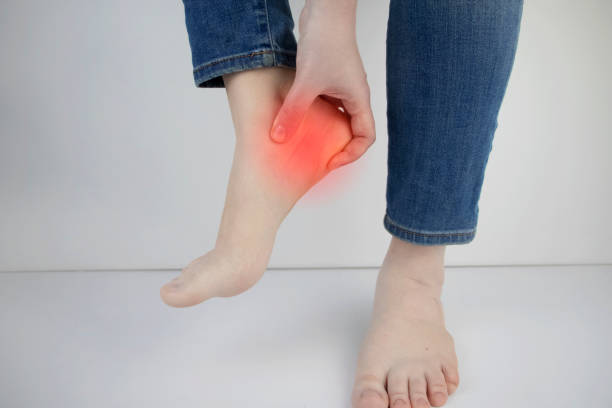You might think it’s just a sore heel or tight arch, but a plantar fasciitis specialist sees much more with a single glance. What feels like a simple ache could be hiding years of strain, subtle imbalances, or movement patterns that need correction. From callus placement to how you grip the ground with your toes, these tiny details tell a much bigger story.
Uneven Pressure Distribution Across the Soles
A plantar fasciitis doctor often spots pressure imbalance without you ever taking your shoes off. Slight changes in how your weight shifts across your soles can be traced by wear patterns on your footwear or changes in your gait. If your heel strikes too hard or your arch doesn’t support properly, it sends clear signals of instability or stress on the plantar fascia—signals most people never notice.
This imbalance can result from tight calf muscles, poor posture, or simply the wrong shoe choice. A plantar fasciitis specialist will often observe a collapse in the arch or a subtle lean during walking, indicating that certain muscles are overworked while others aren’t doing their job. Left untreated, that uneven pressure becomes chronic discomfort, often developing into long-term heel pain or tissue degeneration.
Toe-Grip Behavior Signaling Hidden Foot Discomfort
Many people subconsciously grip the ground with their toes, especially when walking barefoot or in flip-flops. While this may seem harmless, a plantar fasciitis doctor sees it as a red flag. That toe-clenching motion often indicates your foot is trying to create extra stability due to an unstable arch or inflamed fascia.
Plantar fasciitis clients who develop this habit tend to suffer from sore toe joints or tightness along the ball of the foot. Over time, that constant gripping action adds more pressure to the plantar fascia and worsens inflammation. A specialist can identify this pattern early and recommend exercises or footwear adjustments that reduce the need to “grip” with every step.
Slightly Altered Ankle Rotation Patterns Specialists Identify Early
To an untrained eye, your ankles may appear to move just fine. But a plantar fasciitis specialist notices even the smallest rotation that shouldn’t be there. These subtle twists or inward rolls during walking or standing often come from compensation—when your foot tries to avoid pain by adjusting movement elsewhere.
This change in ankle mechanics adds tension to areas that should remain neutral, especially along the heel and arch. Over time, those changes cause inflammation in the plantar fascia. A plantar fasciitis doctor will often use simple walking tests or digital gait scans to pinpoint these motions. Catching them early can prevent more serious alignment issues and persistent heel pain.
Heel Alignment Issues Revealing Chronic Foot Strain
The angle of your heel tells a story—one that a trained plantar fasciitis specialist reads quickly. Whether the heel tilts slightly inward (pronation) or outward (supination), that tilt shifts your weight unnaturally and places abnormal stress on the fascia.
Even a minor misalignment can throw off the mechanics of your entire stride. Over time, this increases the risk of tiny tears in the plantar fascia and worsens inflammation. A plantar fasciitis doctor may suggest orthotics or soft tissue therapies to correct this at the root, which can lead to better balance and noticeable pain relief.
Changes in Foot Temperature Indicating Underlying Inflammation
Warm spots, cool patches, or subtle differences in foot temperature often go unnoticed by patients. But to a plantar fasciitis specialist, these changes are clues. Warm areas might signal inflammation or swelling in the fascia, while cooler areas can indicate poor circulation or restricted tissue mobility.
Foot temperature irregularities are common in clients dealing with chronic heel pain or nerve irritation. A specialist might use thermal imaging or manual palpation to identify hot zones before the pain even intensifies. It’s an early warning system your body uses—if someone knows how to read it.
Overcompensation Movements Specialists Quickly Recognize
Limping, favoring one leg, or even leaning slightly forward while walking are often signs of overcompensation. These actions might not register to you, but they’re instantly recognizable to a trained plantar fasciitis doctor. Overcompensation is a body’s way of protecting a painful area—but it comes at a cost.
The more you shift pressure away from the sore part of the foot, the more you strain surrounding joints, tendons, and muscles. That’s how a small heel pain can snowball into knee, hip, or lower back issues. A specialist will pick up on these habits in your first steps and help rebalance your stride before the chain reaction spreads further.
Minor Skin Callus Patterns Linked to Plantar Fasciitis
Calluses often form on areas that handle too much pressure or repeated friction. While you might think they’re just from walking barefoot or using the wrong shoes, a plantar fasciitis specialist knows they mean more. The location and thickness of a callus can reveal how your weight is distributed—or where it’s not supposed to be.
For example, a thick callus near the ball of the foot may indicate your heel isn’t absorbing shock correctly due to fascia pain. Similarly, calluses forming on one side only might mean your arch is collapsing inward during movement. Identifying these patterns helps a plantar fasciitis doctor fine-tune treatment with stretching, custom orthotics, or regenerative therapies aimed at realigning the foot.


